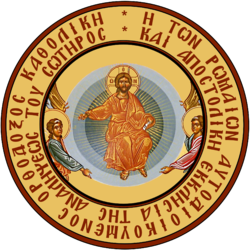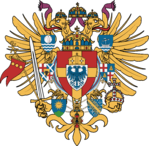Orthodox Church of Rhōmanía
| Romans' Self-Administered Orthodox Catholic and Apostolic Church of the Ascension of The Saviour | |
|---|---|
| Ἡ τῶν Ῥωμαίων Αὐτοδιοικούμενος Ὀρθόδοξος Καθολικὴ καὶ Ἀποστολικὴ Ἐκκλησία τῆς Ἀναλήψεως Τοῦ Σωτῆρος | |
 Seal | |
| Classification | Eastern Orthodox |
| Orientation | Greek Orthodoxy |
| Scripture | Septuagint, New Testament |
| Theology | Eastern Orthodox theology |
| Active | 15 September 2020 |
| Holy See | New Constantinople |
| Territory | New Constantinople (de jure) Rhomania (de facto) |
| Leadership | |
| Primate | Bartholomew I of Constantinople (de jure) |
| Apostolic Caretaker | Emmanuel I & II |
| Important places | |
| Church of the Ascension of the Saviour, New Constantinople | |
| General data | |
| Languages | Medieval Greek |
| Churches | 1 |
The Roman Orthodox Church, often called the Orthodox Church of Rhōmanía (OCR), and, officially, the Romans' Self-Administered Orthodox Catholic and Apostolic Church of the Ascension of The Saviour (Roman Greek: Ἡ τῶν Ῥωμαίων Αὐτοδιοικούμενος Ὀρθόδοξος Καθολικὴ καὶ Ἀποστολικὴ Ἐκκλησία τῆς Ἀναλήψεως Τοῦ Σωτῆρος) is a de facto self-administered Orthodox Christian church exercising jurisdiction over the Roman capital of New Constantinople. Split from the Church of Greece on the 15th of September 2020, it is the official imperial church of the Basileia of the Romans, claiming to be an autonomous part of the Ecumenical Patriarchate of Constantinople.
Though having a limited jurisdiction in the territory of Rhomania, the church welcomes all Orthodox Christians from all around the world in several prayer ceremonies, theological discussions, charitable works and other programmes and events. The church is also unique in not currently having any priests or bishops, thus not being able to perform any liturgies, baptisms or any other services, with its actions currently reduced to domestic and international events among Orthodox individuals.
The Church is also unique in being the only currently known micronational Christian Church owning a Church building, the Ascension of the Saviour Cathedral in New Constantinople, which serves as the See of its Bishop, which is currently vacant.
It also considers itself a continuation of both the Ashukov Orthodox Diocese of Mouzilo (despite the two not having any overlapping jurisdictional territories) and the Orthodox Association of Rhomania, a State organization that ceased to exist on the day the Church was established.
The Roman Orthodox Church currently shares no communion with any other Orthodox Christian church.
Bible Canon
The Biblical Canon of the Orthodox Church of Rhōmanía is the common canon used by all Orthodox Christian Churches, namely the 39 Hebrew Scriptures plus the 10 Deuterocanonical Books for the Old Testament, and the regular 27 books of the New Testament.
The OCR uses the Koine dialect of ancient Greek for liturgical purposes. Koine Greek is considered to be the sole authoritative language for the Scriptures that cannot be substituted by any subsequent translation. As such, only the Greek Old Testament (LXX - aka Septuagint) and the Patriarchal Text of 1904 (ΒΥΖ04) of the New Testament have official status within the Church, as is common with all other Greek Orthodox Churches in the world.
Understanding that for a great number of believers reading and/or understanding the sacred texts in their original language is a challenging task, the OCR recommends the following translations for parallel usage with the original texts:
- Modern Greek
Today's Greek Version (TGV), Hellenic Bible Society - English
Old Testament: New English Translation of the Septuagint (NETS), Oxford Press
New Testament: The Eastern/Greek Orthodox New Testament (EOB)
- Alternatively: The Holy Bible, Revised Standard Version with Apocrypha (RSV)
